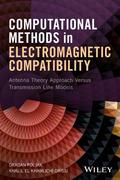Computational Methods in Electromagnetic Compatibility
Antenna Theory Approach Versus Transmission Line Models

1. Edition June 2018
432 Pages, Hardcover
Wiley & Sons Ltd
Offers a comprehensive overview of the recent advances in the area of computational electromagnetics
Computational Method in Electromagnetic Compatibility offers a review of the most recent advances in computational electromagnetics. The authors--noted experts in the field--examine similar problems by taking different approaches related to antenna theory models and transmission line methods. They discuss various solution methods related to boundary integral equation techniques and finite difference techniques.
The topics covered are related to realistic antenna systems including antennas for air traffic control or ground penetrating radar antennas; grounding systems (such as grounding systems for wind turbines); biomedical applications of electromagnetic fields (such as transcranial magnetic stimulation); and much more. The text features a number of illustrative computational examples and a reference list at the end of each chapter. The book is grounded in a rigorous theoretical approach and offers mathematical details of the formulations and solution methods. This important text:
* Provides a trade-off between a highly efficient transmission line approach and antenna theory models providing analysis of high frequency and transient phenomena
* Contains the newest information on EMC analysis and design principles
* Discusses electromagnetic field coupling to thin wire configurations and modeling in bioelectromagnetics
Written for engineering students, senior researchers and practicing electrical engineers, Computational Method in Electromagnetic Compatibility provides a valuable resource in the design of equipment working in a common electromagnetic environment.
Part I: ELECTROMAGNETIC FIELD COUPLING TO THIN WIRE CONFIGURATIONS OF ARBITRARY SHAPE
Chapter 1: Computational Electromagnetics-Introductory Aspects
1.1 The Character of Physical Models Representing Natural Phenomena
1.2 Maxwell's Equations
1.3 The Electromagnetic Wave Equations
1.4 Conservation Laws in The Electromagnetic Field
1.5 Density of Quantity of Movement in The Electromagnetic Field
1.6 Electromagnetic Potentials
1.7 Solution of The Wave Equation and Radiation Arrow of Time
1.8 Complex Phasor Form of Equations in Electromagnetics
References
Chapter 2: Antenna Theory Versus Transmission Line Approximation-General Considerations
2.1 A Note On Emc Computational Models
2.2 Generalized Telegrapher's Equations for The Field Coupling to Finite Length Wires
2.3 Single Horizontal Wire in A Presence of a Lossy Half-Space: Comparison of Analytical Solution, Numerical Solution and Transmission Line Approximation
2.4 Vertical Wire in A Presence of a Lossy Half-Space: Comparison of Analytical Solution, Numerical Solution and Transmission Line Approximation
2.5 Magnetic Current Loop Excitation of Thin Wires
References
Chapter 3: Electromagnetic Field Coupling to Overhead Wires
3.1 Frequency Domain Models and Methods
3.2 Time Domain Models and Methods
3.3 Applications to Antenna Systems
References
Chapter 4: Electromagnetic Field Coupling to Buried Wires
4.1 Frequency Domain Modelling
4.2 Time Domain Modelling
References
Chapter 5: Lightning Electromagnetics
5.1 Antenna Model of Lightning Channel
5.2 Vertical Antenna Model of a Lightning Rod
5.3 Antenna Model of a Wind Turbine Exposed to Lightning Strike
References
Chapter 6: Transient Analysis of Grounding Systems
6.1 Frequency Domain Analysis of Horizontal Grounding Electrode
6.2 Frequency Domain Analysis of Vertical Grounding Electrode
6.3 Frequency Domain Analysis of Complex Grounding Systems
6.4 Time Domain Analysis of Horizontal Grounding Electrodes
Part II: ADVANCED MODELS IN BIOELECTROMAGNETICS
Chapter 7: Human Exposure to Electromagnetic Fields -General Aspects
7.1 Dosimetry Fundamentals
7.2 Coupling Mechanisms
7.3 Biological Effects
7.4 Safety Guidelines and Exposure Limits
7.5 Some Remarks
References
Chapter 8: Modelling of Human Exposure to Static and Low Frequency Fields
8.1 Exposure to Static Fields
8.2 Exposure to Low Frequency (LF) Fields
References
Chapter 9: Modelling of Human Exposure to High Frequency (HF) Electromagnetic Fields
9.1 Internal Electromagnetic Field Dosimetry Methods
9.2 Thermal Dosimetry Procedures
References
Chapter 10: Biomedical Applications of Electromagnetic Fields
10.1 Modelling of Induced Fields Due to Transcranial Magnetic Stimulation (TMS) Treatment
10.2 Modelling of Nerve Fibre Excitation
References
Index
KHALIL EL KHAMLICHI DRISSI, Ing., Ph.D., is the Full Professor at the Department of Electrical Engineering at Clermont Auvergne University in France. In addition, he is senior researcher at Institute Pascal Laboratory and member of National Council of Universities (CNU-63).


